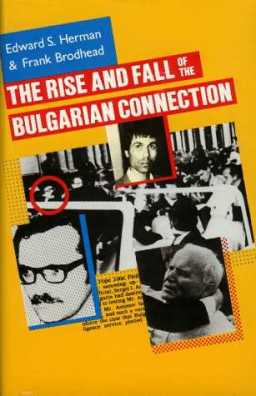The rise and fall of the Bulgarian Connection
Edward S. Herman and Frank Brodhead
(Sheridan Square Publications, New York, 1986)
When the Turkish Grey Wolves hold rallies they howl collectively. So, at times, do journalists of the ‘free press’. In 1979 Edward Herman wrote After the Cataclysm with Noam Chomsky in which they shredded Western reportage of Khmer Rouge rule in Kampuchea. Useful leftists like Pilger and Fenton lined up to help convince the world that a few thousand Maoists, rather than U.S. foreign policy, were responsible for millions of deaths from starvation in a terror-bombed economy.
This time Herman, with Brodhead, targets ‘the Bulgarian connection’, and in particular a clique of disinformation agents starring the ‘Big Three’ – Claire Sterling, Paul Henze and Michael Ledeen. Not only did these three have access to the most widely viewed TV slots and the most influential papers, they could also insist that no opposition views were aired alongside their own. Countless millions were fed ‘KGB shoots Pope’, while the acquittal of the Bulgarians last March was lucky to hit the back pages.
The real plot against the Pope – by Ali Agca and his Grey Wolves comrades – is clearly visible within the context of their politics. Likewise their motives. For the last 50 years Turkish fascism has laid claim to vast portions of the USSR. In WW2 the Nazis recruited 100,000 Soviet POWs from Soviet republics such as Turkestan. Pan Turkish plans to attack the Soviet Union were only abandoned after Stalingrad and support was switched to the Allies – a move heralded by the banning of the pro-Nazi party.
By the 1970s however, the fascist NAP and its Grey Wolves ‘youth wing’ were operating ‘legally’ and helping the state to smash the Turkish left. By 1977 the NAP was in the coalition government and controlled the Education Ministry (in order to terrorise students) and the Customs Ministry (which facilitated the flow of drugs, guns and terrorist cadre in and out of Turkey.)
Then in September 1980 the military took over again and the Wolves were banned. They’d served their purpose. Some were even indicted for some of the thousands of murders committed during the terror. But the challenge to the Russian Empire by Solidarity in Poland gave a measure of hope to desperate men. Moscow promised not to invade Poland if the Church could dampen the struggle (and, presumably, give the Polish Stalinists time to organise the coup). Some Grey Wolves came to believe that if the infidel Pope would not inflame anti-communist revolt, it would be better if he was assassinated in a way that would make the KGB look like culprits. Poland would rise in fury, signalling the break-up of the USSR.
Although Agca may have been a nut, Herman and Brodhead show he was no lone one, but an experienced and valued terrorist assassin who worked with the Wolves right up to the shooting in St. Peter’s Square on May 13 1981.
This still leaves the question of a larger conspiracy. The Wolves had strong links with the Italian and German far-right. In the early 1980s the Munich Beerfest and the Bologna Station massacre were just two manifestations of the fascist Strategy of Tension that cost hundreds of lives in Western Europe (and included a plan to use British Nazis to bomb the Notting Hill Carnival – fortunately thwarted).
Herman and Brodhead argue that there is no hard evidence to suggest the CIA led or even allowed the plot against the Pope. The KGB certainly look less guilty than the CIA. But the CIA played a crucial role in the second conspiracy – the cover-up. To return to the ‘big three’, Henze, author of The Plot to Kill the Pope was CIA station chief in Turkey. Ledeen, of the Georgetown Centre for Strategic and International Studies, and author of Grave New World, is a colleague of Francisco Pazienza who acted as a Mr Fix-it between P-2, Italian intelligence and the far right. Sterling acts as a conduit for Ledeen, Henze and their agencies behind her front as Readers Digest hack and archetypal American abroad innocently stumbling into the intrigues of the ‘Evil Empire’.
Herman, Brodhead and Chomsky work with the Institute for Media Analysis (145 West Fourth St. New York 10012). After encountering their work you will never read your quality liberal daily in the same way again.
David Black
